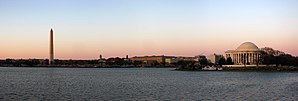
Back Área metropolitana de Washington AST Washington D.C.'s storbyregion Danish Metropolregion Washington German Vaŝingtona metropola areo Esperanto Área metropolitana de Washington D. C. Spanish Washingtongo eremu metropolitarra Basque منطقه کلانشهری واشینگتن Persian Région métropolitaine de Washington French Area metropolitana di Washington Italian Вашингтон агломерациясы Kazakh
Washington metropolitan area National Capital Region | ||
|---|---|---|
| Nickname(s): | ||
 Interactive Map of Washington–Arlington–Alexandria, DC–VA–MD–WV MSA
| ||
| Country | ||
| States | ||
| Principal municipalities | Washington, D.C. Arlington, VA Alexandria, VA Dale City, VA Centreville, VA Reston, VA Leesburg, VA Manassas, VA Fredericksburg, VA Tysons, VA Germantown, MD Silver Spring, MD Waldorf, MD Frederick, MD Gaithersburg, MD Rockville, MD Bethesda, MD Bowie, MD Charles Town, WV | |
| Area (2010) | ||
| • Urban | 3,644.2 km2 (1,407.0 sq mi) | |
| • Metro | 14,412 km2 (5,564.6 sq mi) | |
| Elevation | 0–716 m (0–2,350 ft) | |
| Population | ||
| 6,385,162 (6th) | ||
| • Density | 375.4/km2 (972.2/sq mi) | |
| • Urban | 4,586,770 (8th) | |
| • CSA (2016) | 9,546,579 (4th) | |
| Urban pop as of 2016 | ||
| GDP | ||
| • MSA | $660.6 billion (2022) | |
| Time zone | UTC−5 (EST) | |
| • Summer (DST) | UTC−4 (EDT) | |
The Washington metropolitan area, also referred to as the D.C. area, Greater Washington, the National Capital Region, or locally as the DMV (short for District of Columbia, Maryland, and Virginia), is the metropolitan area centered around Washington, D.C., the federal capital of the United States. The metropolitan area includes all of Washington, D.C. and parts of Maryland, Virginia, and West Virginia. It is part of the larger Washington–Baltimore combined statistical area, which is the third-largest combined statistical area in the country.
The Washington metropolitan area is one of the most educated and affluent metropolitan areas in the U.S.[7] The metro area anchors the southern end of the densely populated Northeast megalopolis with an estimated total population of 6,304,975 as of 2023 estimates,[8] making it the seventh-most populous metropolitan area in the nation,[9] as well as the second-largest metropolitan area in the Census Bureau's South Atlantic division, following Metro Atlanta.[10]
- ^ "After initial obscurity, 'The DMV' nickname for Washington area picks up speed". The Washington Post. July 30, 2010. Archived from the original on August 26, 2023. Retrieved September 18, 2017.
- ^ Yager, Jane (July 30, 2010). "Nation's Capitol Now Known as 'the DMV'". Newser. Archived from the original on March 11, 2016. Retrieved March 11, 2016.
- ^ "2020 Population and Housing State Data". United States Census Bureau. August 12, 2021. Archived from the original on August 21, 2021. Retrieved August 21, 2021.
- ^ "Annual Estimates of the Resident Population: April 1, 2010 to July 1, 2016: CSA". 2016 Population Estimates. United States Census Bureau, Population Division. March 2016. Archived from the original on February 13, 2020. Retrieved March 6, 2018.
- ^ "Census Urban Area List". United States Census Bureau. 2010. Archived from the original on November 15, 2018. Retrieved March 6, 2018.
- ^ "Total Gross Domestic Product for Washington-Arlington-Alexandria, DC-VA-MD-WV (MSA)". fred.stlouisfed.org. Archived from the original on November 13, 2023. Retrieved January 3, 2024.
- ^ "Washington area richest, most educated in US: report". The Washington Post. June 8, 2006. Archived from the original on December 22, 2017. Retrieved November 19, 2012.
- ^ "2020 Population and Housing State Data". The United States Census Bureau. Archived from the original on August 12, 2021. Retrieved August 22, 2021.
- ^ "Four Texas Metro Areas Collectively Add More Than 400,000 People in the Last Year, Census Bureau Reports". United States Census Bureau. Archived from the original on October 26, 2022. Retrieved December 6, 2017.
- ^ "Census Bureau Regions and Divisions with State FIPS Codes" (PDF). US Census Bureau. Archived (PDF) from the original on December 19, 2017. Retrieved August 30, 2018.






